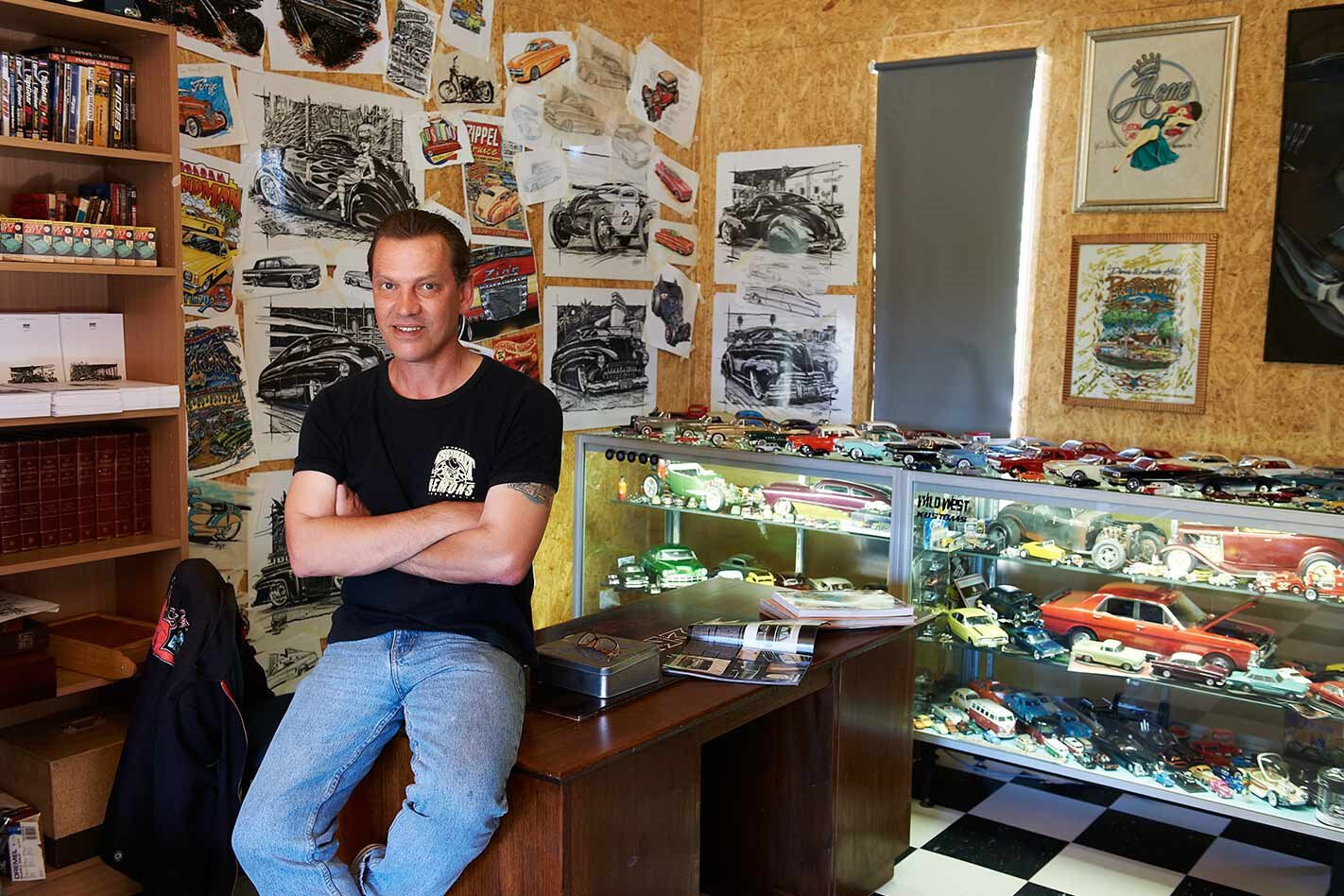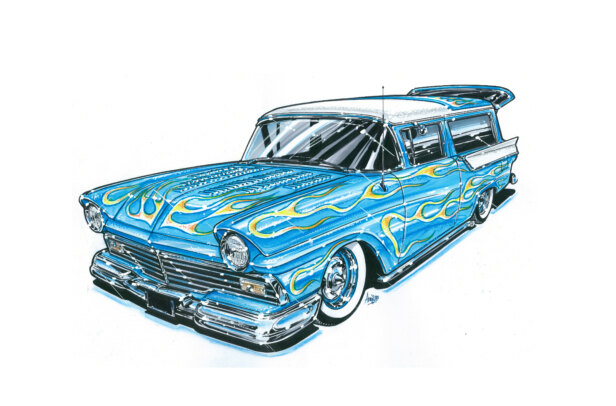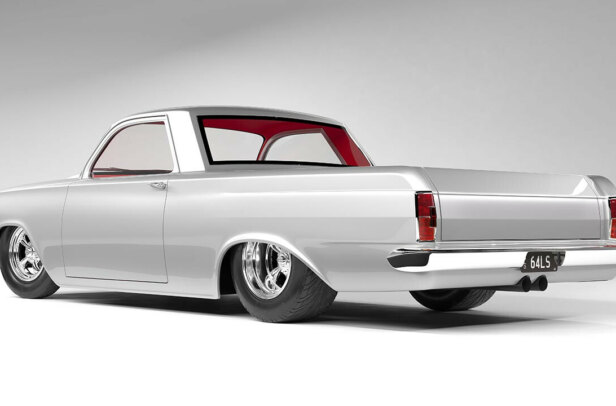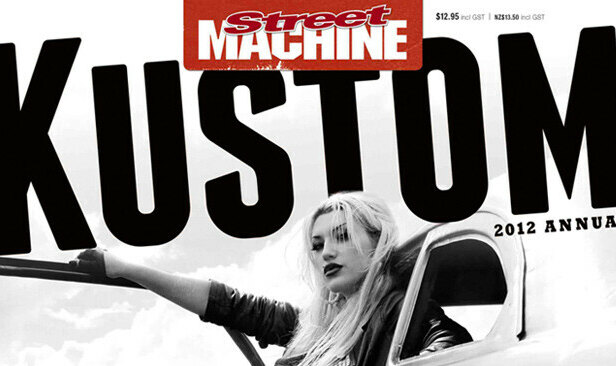This article on Aden Jacobi was originally published in the Feburary 2012 issue of Street Machine
THE face may not be familiar but if you’ve been around the street machine traps for a while you’re sure to recognise the artwork of Aden Jacobi. It’s not only adorned car show posters and the pages of magazines for decades but also brightened the flanks of some of Australia’s fastest drag cars. And more than a few high-end street machines, hot rods and customs have been built from his design work.
So where did the love of art and cars stem from?
My parents were a huge influence on me. My mum is a great artist with a keen eye for detail and my dad is very talented with everything he does. We grew up being ferried around in a custom FJ and a restored Mercedes, and he was a dab hand with paintwork. In the early 70s Dad bought me a Dragster pushbike; money was tight so it was a little worse for wear and I remember watching him brush-coat the mudguards white to spruce it up. He then smoked them with a candle to give it a custom look. He even did a custom paint job on his FJ using one of those old brass hand-pump bug sprayers.
Do you remember when you first started to draw cars?
As a kid in the 60s I spent some time in hospital and Dad brought in three hot rod magazines. I can clearly remember staring in awe at Gene Winfield’s Solar Scene Mercury and Rick Zocchi’s Winfield-built ’62 Pontiac. That was it; I was hooked and began by tracing stuff until I could go it alone. I still have those magazines and the picture on one of my business cards is me reading one of the issues.
Many of Aden’s drawings have ended up as actual top end cars, including Paul McKennariey’s ’48 Hudson, Pete Elliot’s ’37 roadster and Gangsta EH
So how did you end up turning the passion into a career?
Through a lot of luck and the odd bit of fabrication [laughs]. At 16 we moved from Geelong to Brisbane and my parents said I’d have to stay at school unless I got into art college or could land a job. I went for a darkroom gig at a local ad agency and bluffed my way through the interview by saying that my certificates were still in transit from down south! They hired me and on the first day I asked my offsider to show me the ropes. He said: ‘You’re farken kidding me, aren’t you?’ but I picked it up pretty quickly. The same firm had an illustrator who was a full-on boozer so he didn’t always get the concept work done in time. I stuck my hand up to have a go and it all just grew from there. I worked at a number of ad agencies and signwriters before going it alone in 1987.
I remember having your Street Machine Nationals posters on the wall as a teenager.
That was through the Australian Street Machine Federation. I was already doing the Queensland Powernats art, so the ASMF asked if I could have a go at these posters as well. It was a lot of fun. Looking back on them now, you can still pick the cars I stylised in the drawings which is a good nostalgia trip. I do a lot of T-shirt designs and posters for car events here in Australia such as the Zippel Cruise and internationally. I also did the Welcome to Castlemaine sign with Rod Hadfield’s Hot Rod Lincoln on it.
Aden gets to work chopping the roof on his ’49 Ford with plenty of help from his fellow Asphalt Demons
How old were you when you started airbrushing?
I was 12 and our neighbour was right into dune buggies, so he got me to paint a beach scene on one of his projects. My parents had bought me an airbrush but the problem was it used a small pressurised air can and would only last about 20 minutes. Of course I didn’t get very far with the paintjob so we hooked it up to an old inner tube, which I sat on to pressurise it while I painted. It turned out pretty well and I’ve airbrushed ever since.
When did you get your first car?
In 1973 I found an old custom FJ sedan that had rolled pans front and rear and ’65 Chev tail-lamps. I was 12 and saw all of these kids jumping on the roof; the people who owned it were being evicted so were happy for me to just take it. I ended up swapping it with the same neighbour in exchange for him making me a set of chopper forks for my Dragster. We cut up my sister’s bike for the extra tubing and that didn’t go down very well [laughs]. I then bought an FJ ute for $150 with some school mates, which we started to do up and would drive around the backstreets but my brother smashed it learning to drive. We then bought another FJ ute which we drove to school! Over the next few years I had many early Holdens, Fords and Vals, all treated to some mild tricks. I ended up with a ’65 Phoenix which was the first of many US cars, but I ended up swapping it for a verandah.
First published work?
Probably in Van Wheels! I was 15 when Van Wheels hit the shelves and it was awesome — hot vans, tits and crude humour, what more could you want? I loved it and still have every copy. I was stoked to see my Misty Blues II concept in issue 9, which was an XY version to follow on from Greg Tarte’s XB.
What would be your most memorable work?
Definitely doing the design and paint for the Bob Power T-bird ’Slammer; it was the first sedan to run 200mph in Australia, so it’s great to be associated with it. Other memorable work would be the airbrushing on Ray Bernard’s ’57 Nomad, the Brett Stevens Funny Cars and more recently Andrew Cole’s ’63 ’Vette. One of my proudest achievements would be the custom paintwork I did on a good friend’s Harley. Billy’s of viking heritage so I airbrushed that theme around the stock factory scalloped paint. I said to him: ‘Don’t expect it to win any trophies,’ because of the standard paint underneath but it’s won 37 awards, with five State and three Nationals titles including Top Paint.
Your walls are covered with fantastic custom and hot rod art — is it something new?
Lately I’ve been doing a lot more poster-size illustration work and faux magazine covers, and I just got back from the Mooneyes show in Japan where I was a featured artist. It’s a great feeling to meet and rub shoulders with some of your heroes.
What else do you dabble with?
I’m an unofficial draftsman and do a lot of artist’s impression concepts and floor-plan work for new homes and remodels. I even won a Queensland HIA Award in 2008 for the Custom Built Home up to $250,000 category, which was pretty cool. It’s long been a tradition to include our old ’65 Phoenix in any of the ‘busier’ work I do, so you can usually tell my posters and house concepts by the blue Dodge featuring somewhere in the background or garage.
A couple of neat concepts Aden dreamed up for the 2011 Hot Rod Annual – an AU Falcon ute with an XL front and a VY ute with an FC nose
What are you up to with your own rides?
The F100 is a ’62 model and it’s my daily driver; I’ve always loved the gasser look. It still runs the original Y-block and will be getting a few cosmetic changes in the near future. I’m building a ’61 Karmann Ghia hardtop for Kerry, that’s going to be a pillarless hardtop and will have a pseudo Studebaker bullet nose. I’m one of the founding members of the Asphalt Demons and there’s always someone in the club up to mischief with a cool project.
Who would you rate as your greatest influences?
Gene Winfield, Keith Weesner, Larry Watson and of course Rod Powell, but we have a lot of Australian legends who I greatly admire. Artist Robert Smitt, Dale Fisher, Tony and Dave Andrew, Ron Wickham, Paul Kelly and the duo of Joe Pirotta and Charlie Caruana have all built great cars, and it’s fantastic to see them receiving more recognition in recent years. John Evans from Van Craft was probably the reason I got into airbrushing. One of the most humbling experiences I had recently was seeing some of my own artwork hanging proudly on Rod Powell’s wall; I take that as a great compliment and it makes me feel that I’m doing something right.




Comments